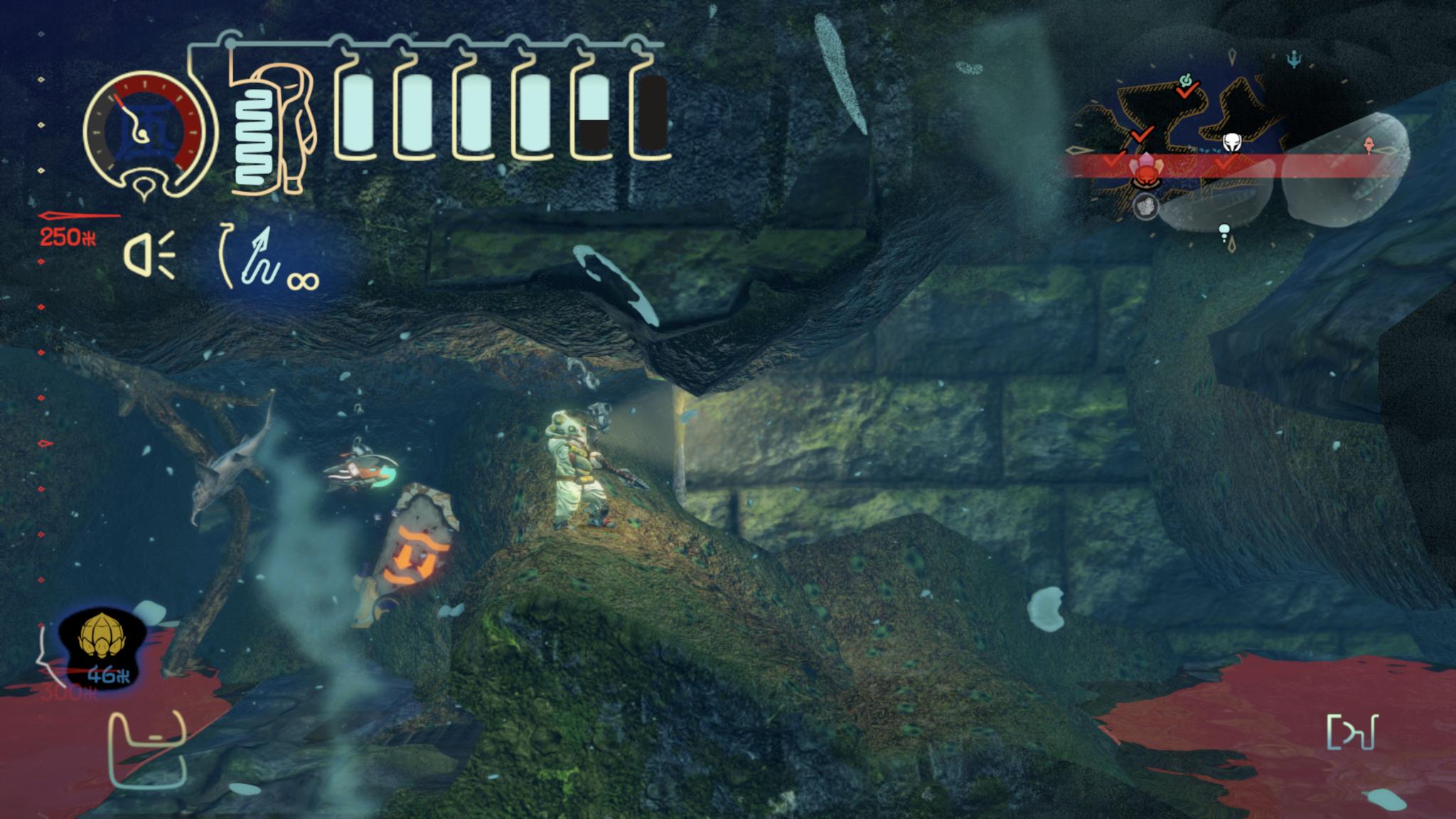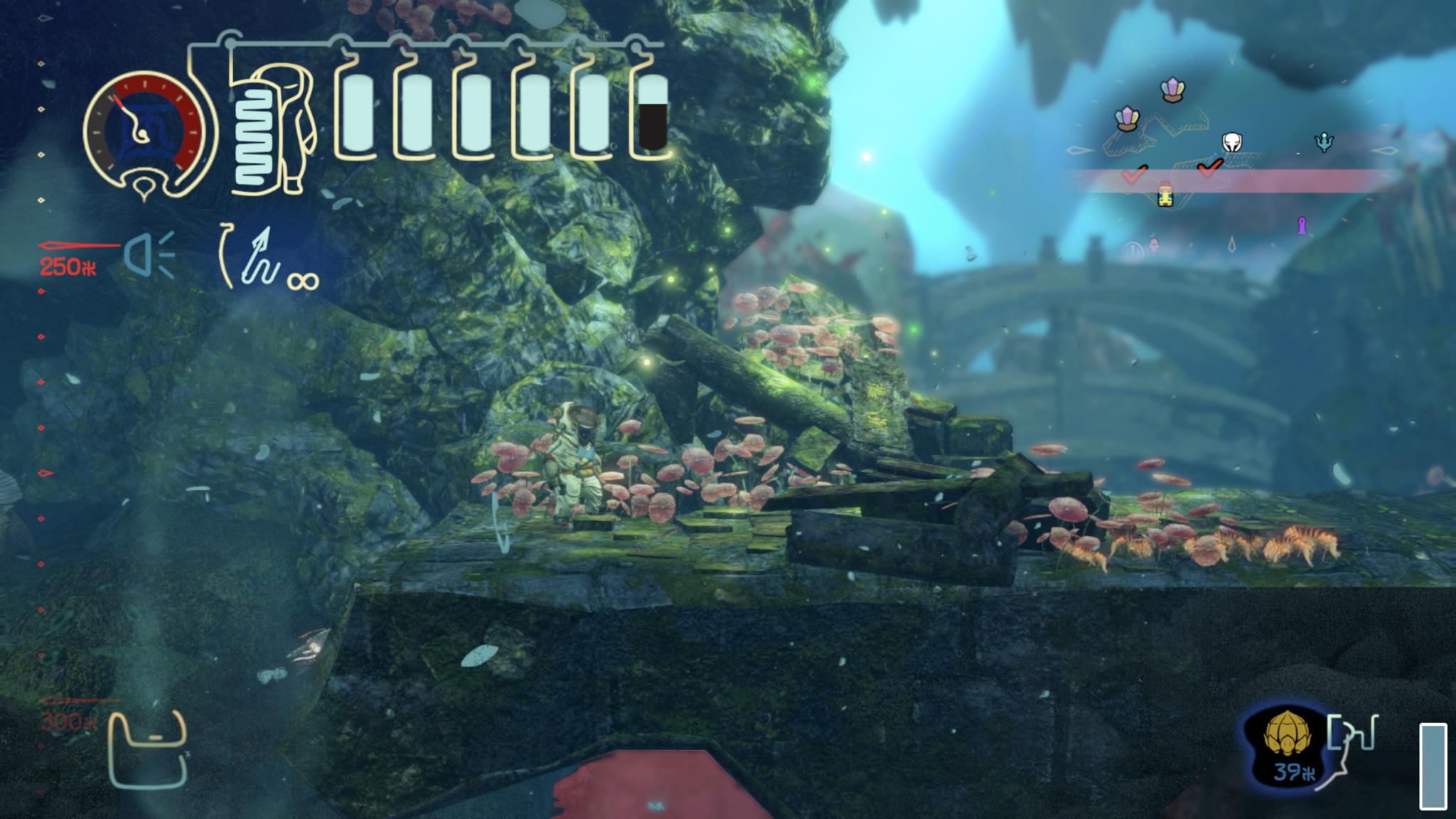The biggest, most popular video games tend to be power fantasies. They let us make gravity-defying leaps, mow down evildoers with pinpoint accuracy, and save the world from destruction. Capcom's Apple Arcade-exclusive underwater adventure Shinsekai: Into the Depths flips that on its head. As your weary, baggy-suited hero waddles ever deeper into the remains of a world long past saving, you only grow more and more aware of how small and helpless you are.
Sure, Shinsekai is a "Metroidvania" — an action-adventure game that lets you wander freely around a large map, discovering upgrades that gradually give you access to previously unreachable areas. But it's a sterling example of that well-worn genre, and all the rarer for its status as a Mac exclusive. Maybe Untitled Goose Game has (deservedly) stolen its spotlight, but I'm surprised more people aren't talking about just how good Shinsekai is in every way.
Elegy for a drowned future
Humanity had a good run, but as Shinsekai opens, it seems to be on its last legs. The oceans have risen to cover the world we know; humans retreated underwater, for a time, but now ever-encroaching spikes of ice are slowly advancing from the planet's surface and squeezing out the remnants of our species. You meet the game's protagonist – nameless, voiceless, struggling through life in an oversized and unflattering diving suit – as one of those malevolent ice sheets devours their sad little underwater home.
As you search for some other safe place to eke out an existence, the game gradually reveals just how much of humanity has been lost beneath the waves. You'll find drawings and evidence that there were once other divers like you. And you'll start to wonder where they all are – and whether you're the last one left.
Shinsekai lets its simple story unfold mostly through the gameplay itself – the things you see, the secrets and discoveries you find, and the inferences you draw from them. Occasional in-game cutscenes play out wordless but crystal-clear story beats; Capcom's put a lot of work into ensuring that your protagonist's body language speaks volumes.
This less-is-more approach ends up adding to the crushing sadness that the game accumulates as you upgrade your pressure suit to move deeper and deeper into the dark of the ocean. Shinsekai didn't need to include a scene where your wandering mariner finds an abandoned diving helmet, and communes with it in a poignant moment of paying respects to those lost. But the game's far richer for it.
Welcome to Deathsville. Population: You.

In Shinsekai, everything wants to kill you. Everything. Whether you fall too far and damage your suit, stumble into the red-marked depths where the pressure's too crushing, get impaled by a sudden ice spike, linger too long on frozen ground until your suit begins to crack, or anger the wrong random sea creature, you do not lack for ways to kick the bucket. Heck, standing still and doing nothing can kill you, assuming you wait long enough to run out of air.
iMore offers spot-on advice and guidance from our team of experts, with decades of Apple device experience to lean on. Learn more with iMore!
Yet the game never gets depressing or frustrating despite this. It never even feels stressful. The chill, mellow soundtrack and frequently gorgeous visuals counteract the omnipresent possibility of death. (And if you do die, the game doesn't punish you too harshly, reviving you somewhere reasonably near your point of expiration to try again.)
Your character's weary, it's-a-living attitude toward all this also lends some levity to the game. Crack an air tank in a too-hard landing, and your character shakes their head with unmistakable annoyance and ruefulness. Whoever's in that diving suit, they have clearly seen some stuff.
And like them, you quickly accept that your life in Shinsekai involves wandering the seabed in search of hidden caches and mineral deposits. You'll also meet fantastic and often gorgeous sea life; an encyclopedia of marine life, accessible from the menu screen, gives you a closer look at the critters you've found thus far from any angle.
Then, having met that gorgeous sea life, you'll bash it to death with your climbing tool, the better to harvest its precious gooey resources.
I kid, of course. You don't always have to bludgeon the ocean's precious wonders. Sometimes you can skewer them with your speargun, too.
Perfectly balanced
This constant quest for resources could feel like a grind. But somehow, it never does. That owes partly to how swiftly you come to appreciate that these otherwise boring acts are literally keeping you alive – giving you the resources to craft more ammo, power-ups, repair kits, and so forth. And it partly comes from the genuine treasure-hunt delight of exploring all the game's weird nooks and crannies.
For a game with a vast map packed with crevasses and caverns, nothing in Shinsekai tends to feel same-y. The levels start out with "hey, you're underwater, what more do you want?" but rapidly get odder, lovelier, and more interesting. Scrambling through the collapsed, diagonal remains of a long-gone office building, hearing the distant echo of ghostly Muzak, is just the start of the adventures this game has in store for you.
And exploring those levels never gets too frustrating, nor too predictable. You can clang bells or hit the ground with your tool to search for nearby goodies, and while they might show up on your map display, their precise location and the terrain around them might not, depending on how far away they are. Knowing there's something worth finding, but not knowing where it is or how you'll get to it, becomes part of the game's exploratory fun.
Even the controls epitomize the gracefulness of Shinsekai's design. They land in the sweet spot between "not responsive enough" and "perfectly responsive," and that awkward middle ground works really well. Because, hey, you're trudging around underwater in what's basically a small person-shaped tent; you're not supposed to move with balletic precision.
You're supposed to clamber and claw to get a handhold on a rock face, or bob hilariously when you try to pop out of the water into an air pocket, or flail around embarrassingly as you vent air from your suit to jet you from one place to another. Those struggles make the game feel more authentic without getting too much in your way. They also render the game's hero more sympathetic and relatable, despite the protagonist's opaque helmet.
A weird, intimate sort of beauty
Shinsekai is delightful to behold. The programmers employ clever tricks and tech to depict its underwater world, with shimmering bubbles and near-photorealistic sea life. And there's a singular, distinctly Japanese character to the game's artistry. Illustrations feel hand-drawn, kanji stamps figure prominently into the interface, and some of the weirder machinery you'll find sports striking, colorful patterning reminiscent of kites, or the hues and linework in traditional ukiyo prints. (Appropriately enough, that term translates to "floating world.")
Though it comes from megastudio Capcom, home to everything from Mega Man to Resident Evil, Shinsekai is the product of a smaller and reportedly scrappier team within the belly of that particular whale. Fittingly, the resulting game feels both epic and personal; dangerous and relaxing; technically accomplished and profoundly human.
Apple Arcade has a plethora of terrific games to choose from. But if you want to start with the best of the best, consider heading straight for Shinsekai. Amid a real world that often seems far too turbulent, I found a strange solace in the way it made me feel tiny, overmatched, just barely scraping by – and surrounded by wonders.

Nathan Alderman is an iMore contributor. He’s been using Apple computers since his first Apple IIe in 1985, and writing professionally about Macs and their software since 2005. During his 12 years freelancing for Macworld, he covered email clients, web browsers, web design programs, writing apps, and games, and he’s continued to follow those interests at iMore since 2017. An editor and writing coach in his full-time career, he spends his dwindling spare time writing fiction for fun, volunteering for democracy, and contributing to podcasts on The Incomparable Network. Nathan adores his wife and wrangles his alarmingly large children in bucolic Crozet, VA.


